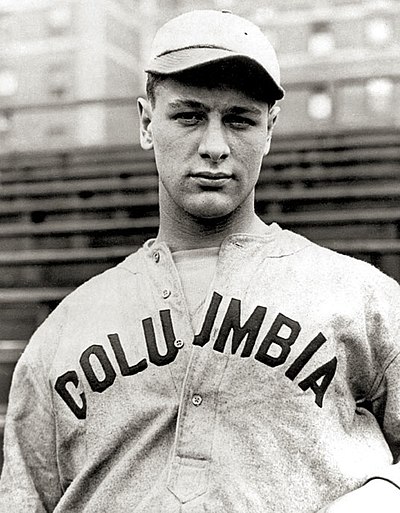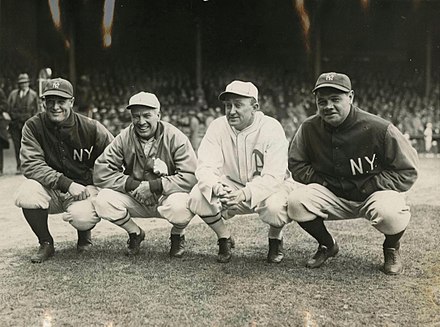Biography

Henry Louis Gehrig better known as Lou Gehrig was born June 19, 1903, at 1994 Second Avenue in the Yorkville neighborhood of Manhattan. His parents were German immigrants. His father was a sheet metal worker who was often unemployed because of his alcoholism and epilepsy, and his mother was a maid, the hardest working supporting the family, and the main parental figure in the family. Gehrig had a hard childhood; he grew up very poor with three siblings and a father who struggle with substance abuse. His family moved around living in different low-income neighborhood in New York City. Gehrig was also the only one of his four other siblings to live past childhood. He had two sisters that died from illness at an early age and a brother that passed away in infancy.

Gehrig earned the name “Lou” to differentiate him from his father who was also named Henry Gehrig. Lou’s baseball talents were first noticed at a high school baseball game at Cubs Park which is now known as Wrigley Field. A crowd of about ten thousand watched as Gehrig’s team was losing by two and Gehrig hit a game winning grand slam out of a major league ball park. This was highly noticed because he was 17 years old at the time. He graduated high school and attended Columbia where he studied engineering for two years. After two years of college, school proved too hard for Gehrig so he switched paths to pursue a career in baseball.

Gehrig was discovered by a Yankee’s scout for his abilities as a lefty power-hitter, and signed with the Yankees April 30th, 1923. Earlier that month the new Yankee stadium opened for the first time. Gehrig was in and out of the minor league system for his first two years on a Yankee’s contract eventually becoming a full-time Yankee in 1925 in which he posted a career year and only got better moving forward. In 1927, Gehrig had one of the best years as a batter of all time and received the award of American league MVP (most valuable player). Gehrig went on to play another twelve years as a Yankee setting record and becoming a seven-time all-star, six-time World Series champion, two-time MVP, a triple crown, and other great achievements. By the end of his career, he held the record for most consecutive games played in the major league (2,130 games). Gehrig spent his entire career as a Yankee until being diagnosed with ALS, which many people know as Lou Gehrig’s disease, later dying in 1941 from the illness. Before his death Gehrig made one of the most iconic speeches of all time known as the “Luckiest Man” speech in which he said farewell to the sport and team he loved. He died in his home in Riverdale, an area in the Bronx. After his death many streets, plazas, and other landmarks were named after the inspiring individual.
Sports in the 1920’s
In the 1920’s, the economy was booming like never before, which began a change in daily life and activities in society. Many workers had more disposable income and leisure time, new stadiums and gymnasiums were built, and newspapers increased their coverage of sports. Improvements in roads made it possible for fans to travel to athletic events in other cities. For the first time, large numbers of Americans began to pay money to watch other people play sports. The 1920’s is also considered the “Golden Age of American Sports”, or the “Age of the Spectator” because of the huge rise in the following and viewing of sports, which only made the sports better. The invention of radio also made it easier for fans to keep up with their favorite teams when they were not able to go watch the game. During the 20’s, baseball was by far the most popular sport that people to watch, follow and play. In 1923, Yankee stadium opened and has since been an iconic landmark of the great city of New York. It was the first stadium in North America with three tears, and seated 58,000 fans. The Yankees went on to win the World Series that same year and the players’ fame grew.

Gehrig’s Rise to fame (1920’s)
Lou Gehrig signed a contract with the New York Yankees in 1923, but he would not become a full-time starter until 1925. Gehrig sat behind first baseman Wally Pipp, until he came in for a struggling Pipp early in the 1925 season and earned himself a starting spot. Two years after Gehrig became a starter he won MVP and a World Series with the Yankees, launching him into fame amongst sports fans. Gehrig became an icon of the late 1920’s which was an era defined by a booming economy. This is the era in which professional athletes began to gain a lot of recognition because of the huge spike in attendance at sporting events and the radio broadcasts of the games. This made Lou Gehrig an icon to most people because of his very strong abilities in the sport on one of the best teams. Gehrig became widely known in the 20’s and throughout his career the public’s view of him would be the same for many years. Gehrig was considered one of the best baseball players which began in the 20’s. He is still considered one of the best players of all time still today, but at the end of his career his image was altered somewhat. Gehrig retired from baseball in the late 1930’s because he was diagnosed with a disease they did not know much about at the time, ALS. This brought much attention to the existence of the disease and it gained the nickname “Lou Gehrig’s disease”. This did not taint him as one of the greatest players, but it brought much attention to his death not as much his career. Lou Gehrig became the well-known legendary player because of the 1920’s, because the era was the beginning of the boom in sports and fans. The 1920’s were known as the “golden age in sports” because of the huge boom in the sports world.

Sources
Gehrig, L., & Gaff, A. D. (2021). Lou Gehrig: The lost memoir. Simon & Schuster Paperbacks.
The San Bernardino County Sun 12 Oct 1927, Page Page 21. Historical Newspapers from 1700s-2000s – Newspapers.com. (n.d.). Retrieved February 27, 2023, from https://www.newspapers.com/image/50594369/?terms=Lou+Gehrig+most+valuable+player&match=1
Summer, J. (n.d.). Sports in the 1920s. NCpedia. Retrieved February 27, 2023, from https://www.ncpedia.org/sports/golden-age-sports
Wikimedia Foundation. (2023, February 12). Lou Gehrig. Wikipedia. Retrieved February 27, 2023, from https://en.wikipedia.org/wiki/Lou_Gehrig
